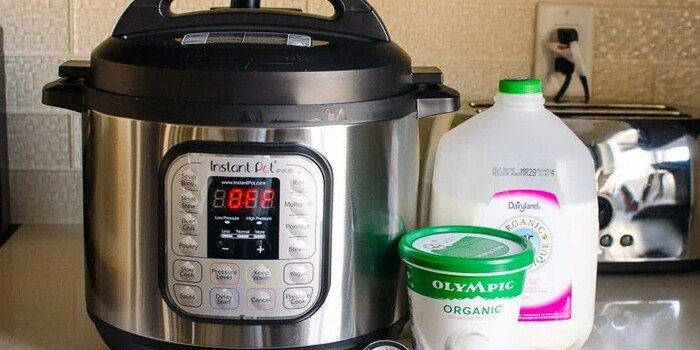Intro
First, the method of yogurt making, especially the subtle process that is needed to make French-style yogurt is a brilliant example of an art of culinary kind, which involves proper scientific perspective and technique along with the tradition of the art.
Coming from a batch made in France, homemade French yogurt is far more satisfying than the commercial types flooding the supermarkets.
French yogurt retention is both thick and creamy and has a mild, intense taste while the French method of fermenting milk to produce yogurt is a fine art.
This compendium analyzes the process of preparing French yogurt at home and how modern kitchen equipment such as the pressure cooker can be used to speed up fermentation.
With this guide, you will not only get to know whether French yogurt cups can handle pressure cooker but most importantly the best recipes together with other vital tips and tricks when preparing French yogurt in your kitchen
Premier Recipes for Mastering Homemade French Yogurt:
Ultra-Thick, Ultra-Creamy French Yogurt:
The problem of achieving the service attributes of French yogurt, especially its velvety elegant texture, is not simple.

Such preparations entail that, besides the purity of substances, the distinctive factors, such as temperature, time, and bacterial culture, in fermentation are well-honed.
Choose whole milk for a creamier end product and an active yogurt culture for fermentation refers to.
The technique is a process in which milk is first heated at 180°F (82°C) to coagulate the proteins:
This step is vital, which makes yogurt thick in its final stage. However, after the milk has cooled to about 110°F (43°C), the right condition for bacterial cultures to thrive, you can mix in the starter culture.
When this is accomplished incubation ensues involving heating at a range of 100°F to 115°F for 8 to 12 hours.
Because of this, a longer fermentation time is practiced so that the lactic acid bacteria can multiply and give that thick, tangy yogurt which is characteristic of the French variety.

Over the years, modern technology has majored in the development of easy-to-use devices that yield great results, with the recent style being the Instant Pot for making yogurt.
This recipe is similar to the La Fermière yogurt and makes the most of the Instant Pot because it allows for control of the temperature during fermentation days.
That is where you just mix your starter with the milk that has been heated then cooled down a little, and then left in your Instant Pot to perform fermentation under appropriate conditions.
This method proves to be most suitable, especially for those who want to tinker with it least.
This eliminates the have to check with additional thermometers or frequently, making a safety net that allows for the yogurt cultures to grow in.
The result?
A delicious, velvety French yogurt with no work.
Q. Are French yogurt cups safe to put in a pressure cooker?
Ans: Yes, French yogurt cups—which are usually made of glass or ceramic—can be used in a pressure cooker as long as they are made of materials that are resistant to heat and have been specially formulated to survive the demands of high temperatures.
Making sure the cups are labeled as an oven- or pressure cooker-safe is crucial since not all glassware or ceramics can withstand the extreme heat produced inside a pressure cooker.
The purpose of using a pressure cooker to make yogurt is not to cook at high pressure; rather, it is to keep the temperature low and steady so that fermentation can occur.
When used properly, the pressure cooker is a great tool for incubating yogurt because it replicates the perfect environment that gradual, natural fermentation normally produces.
Recommendation for Selecting Pressure-Cooking Yogurt:
Heat Resistance of Yogurt Cups: It is also important to ensure that your French yogurt cups do not pose to risks when used in high-temperature areas.
Do not use parts of construction with the tendency of cracking especially due to heat.
Water Levels: In pressure cooking, water must be used to produce the steam that controls heat levels.
But if there is too much water, it Affects the cups to give the yogurt and hence will not ferment nicely.
There has to be a middle ground to create the best conditions.
Low Heat Settings: Conventional pressure cookers with a yogurt function, perform well in incubation with the benefit of low temperatures.
Using this feature means that the bacterial cultures are retained, enabling them to go on with their fermentation responsibilities.
New Types of Yogurt Recipes:
Nevertheless, a lot of yogurt types should interest people who seek to challenge their taste buds further from time to time.
Even more, each recipe brings a new idea for your further enrichment of your homemade yogurt experience.
Yes, Vanilla French Yogurt Copycat Recipe:
Light, creamy, and beautifully vanillic, this recipe provides an Oui yogurt copycat, minus the aspartame and high-fructose corn syrup that mar the UP’s stringently natural descriptor.
Yes & French-Style Strawberry Yogurt:
Here the addition of strawberry makes the French yogurt base sweet and this could be a good recipe for those who have a juicy fruitache in the morning.
A recipe for Greek yogurt made in the Instant Pot.
Thicker than the French yogurt, and full of proteins, Greek yogurt is made by straining the yogurt, which causes most of the whey to be left behind.
This article offers a nice instruction for making restaurants quality Greek yogurt using the Instant Pot.
Quick Make 24-Hour Probiotic Yogurt:
Stored yogurt, when fermented for an extra 24 hours, contains massive quantities of probiotics.

It appeals to consumers who have a passion for healthier foods with good bacteria perfect for digestion.
Key Ingredients:
Looking at each kind of yogurt, it is obvious that the roots of any fantastic one are its components. Whole milk is better to be used to create the thick creamy structure which is characteristic of French yogurt.
For instance, low fat can be processed into a 2% fat content to come up with a lighter product, though the creaminess is lost halfway.
Bargains are equally important; the use of live and active yogurt culture is recommended to ensure that the gift of bacteria needed for fermentation is on hand and alive.
Essential Equipment
In addition to a pressure cooker or Instant Pot, certain tools are indispensable for achieving perfect results:
Digital Thermometer: Temperature regulation is very important when it comes to making yogurt. A thermometer is used to check that milk is not too hot, or too cold before adding the starter.
Glass or Ceramic Yogurt Cups: These are used to transport food and are most suitable for splitting the yogurt into singular serving sizes.
Whisk Something as basic as a whisk is crucial for mixing the yogurt culture with the milk to give the same fermentation level in all the containers.
Avoiding Common Pitfalls:
However, like with the majority of procedures, yogurt-making is not without odds and ends that may go wrong.
Lack of consistent temperature regulation, poor incubation periods, and incorrect general approach towards ingredients are all culprits of unsuccessful attempts.
As most of the errors can be avoided by observing how temperature is managed, and the order of steps strictly adhered to.
Frequently Asked Questions:
Q. What kind of milk is more appropriate for French yogurt?
Ans: Whole milk is generally believed to be optimal for French yogurt because fat gives the final product a thicker and smoother feel.
However, the 2% may be used for a less oil and creamy kind of milk but it will not thicken up as much as the full cream.
Q. Can I use yogurt to rejuvenate it to make more yogurt?
Ans: You can feed your homemade yogurt back into the culture to start another batch, but it is best done for only 3-4 generations before getting the fresh starter.
They on one hand may lose their strength and viability and on the other cause deterioration of the yogurt.
Q. What concerns do I have to consider if I am thinking of adding flavors during the fermentation process?
Ans: Flavors like fruit or vanilla should be added after the stage of fermentation of kefir grains or kefir, respectively.
Adding these ingredients at this state can interfere with the working of bacterial culture used during fermentation and cause variation in the end product.
Conclusion:
Making French yogurt at home transforms a basic dairy product into a delicious culinary creation.
You may make yogurt that is on par with the best artisanal products if you have mastered the fermenting process, are meticulous, and use premium ingredients.
The secret is to create a consistent, regulated environment that supports the growth of the bacterial cultures, whether you use a pressure cooker or an Instant Pot.
Start making yogurt now and experience the delight of producing a more delicious and healthful option than store-bought yogurt.

